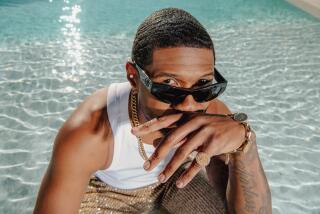Rake’s Progress
- Share via
In person, Hugh Hefner is eerily lifelike. The 80-year-old bard of the booty joins me in the movie room of the Playboy Mansion wearing his prescription pajamas, red brocade smoking jacket, white socks, slippers and a tasteful dress watch, a Cartier, I think.
No arguing, he looks terrific for his age. I don’t know what Hefner is made of, but whatever it is they ought to make space shuttles and highways out of it. So much for the wrath of God.
My purpose here is not to summarize the man or critique the weird pop-culture marble he has carved of himself, but it can’t go unnoted that Hefner’s Q-rating is higher now than it was at Playboy’s zenith in the early 1970s. For that you can credit--if you think the word applies--E! Entertainment Television’s most-watched reality show, “The Girls Next Door,” which follows Hef’s escapades with his three girlfriend-employees, the youngest of whom, 21-year-old Kendra, needs a mute button in the worst way.
Meanwhile, the legendary mansion parties have become legendary again, stocked like trout ponds with A-list celebrities, athletes and camera-hungry hotties. Last month, Playboy Enterprises opened its first Playboy Club in 25 years, atop the 40-story Palms Casino’s Fantasy Tower (a phrase that fills me with chilly dread). The Chicago-based company has its own adult video business, TV channel, online gaming, wireless content (Playboy Bodcast), merchandise and retail interests.
Hefner’s primary role in all this is to be the living, still-breathing embodiment of the brand--the Colonel Sanders of hot chicks, if you will. It’s a few days before the mansion’s Halloween bash, and Hefner’s schedule is crammed with camera crews and interviews, in which he will cheerfully flog the Playboy myth for all it’s worth (and it brought in $338 million in revenue in 2005). He’s the mack granddaddy, the playa-in-chief. I wonder how a smart, self-aware man of 80 years could survive in this decadent fishbowl. “Do you actually live here?” I ask, not so much naively as incredulously. “Oh, yes, and how,” he says.
For a magazine guy like myself, the chance to sit down with Hefner is a remarkable opportunity. No other magazine I can think of--and certainly nothing with the commercial reach of Playboy--has ever had a single editor-in-chief for more than a half-century. Hefner laid out the first issue on his dining room table in 1953, and he still approves the story schedule, the cartoons and, of course, the pictorials. What’s the last story he killed? “I think it was a story about dirty Christmas songs,” he says. “That’s just too Maxim.”
There, I didn’t say it, he did: Maxim. The conventional wisdom has it that Playboy, which seemed like the work of the devil to moral reactionaries in the 1950s, was itself overwhelmed by raunchier fare like Hustler and Penthouse in the 1970s and ‘80s. Conventional wisdom is undoubtedly right. What audience the onanistic rags didn’t steal, the lad books of the last decade--such as Maxim, FHM, Stuff--made a play for. These mags, with their irredeemable materialism, pull-my-finger humor and obsession with alcohol, video games and spring break pudding wrestling (I’m, ah, generalizing here) would seem to have put Playboy and Hefner in an awkward position: Could he compete for the semi-literate frat-boy demographic?
Hefner isn’t biting. “There’s no question that the culture has been dumbed down,” says Hef, but he can’t bring himself to complete the thought: that his magazine has been obliged to lower its sights as well.
And yet it’s worth dropping $5.99 for a Playboy to appreciate Hefner’s gallant and largely unrecognized fight against young male stupidity. Compared to Stuff, Playboy is The Paris Review in fishnets. The November issue has--in addition to the pictorials, video game reviews and a Q&A; with Tenacious D--an interview with a fully clothed Arianna Huffington, part II of a voter guide and a story about Islamic reform. Of all the subversions imputed to Hef, his greatest may be raising the sights of young males above belt height. Hugh Hefner: Reformer.
For real heartbreak, dig up a vintage Playboy at your local library. Because the title has been around so long, and Hef has been tied to the masthead the whole time, Playboy provides a perfectly calibrated measure of American culture--after all, the only thing that has changed is the audience.
As it happens, I have a half-century-old Playboy in my bag--from November 1956, with that distinctive smell of decay and rafters. The letter writers complain about Evelyn Waugh’s takedown of modern art. There’s a portrait of Nat King Cole, a selection from Herodotus, humor by P.G. Wodehouse. Not to mention the astonishing amplitude of Miss November, Betty Blue.
I hand the magazine to Hef, who looks through it. He remembers putting it together. “It’s true, things were better back then,” he says. “Books were smarter, films and music were better, but I recognize as I say it that it makes me sound sort of stuck in the past.”
Right, that wouldn’t be good for business.
More to Read
Sign up for The Wild
We’ll help you find the best places to hike, bike and run, as well as the perfect silent spots for meditation and yoga.
You may occasionally receive promotional content from the Los Angeles Times.






